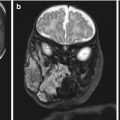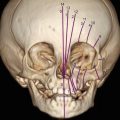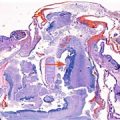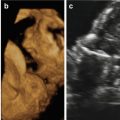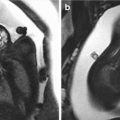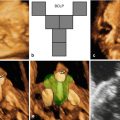Fig. 16.1
Three-dimensional ultrasound at 21.5 weeks of gestation in multiplanar mode and with volume reconstruction. The green toolbar was placed at the level of the midportion of the fetal face and showed a wide, midfacial cleft involving the nasal bone and the palate
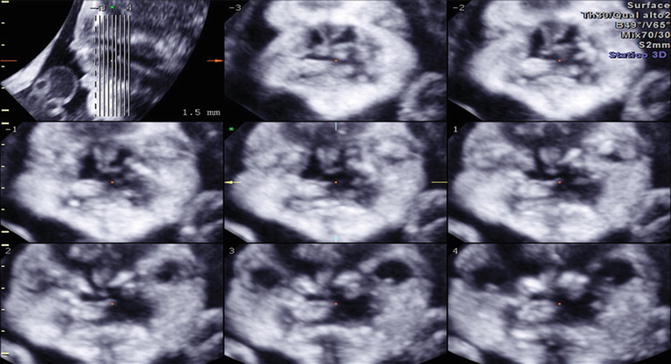
Fig. 16.2
Three-dimensional ultrasound using tomographic ultrasound imaging with thin 1 mm slices. Note the green dot (reference point) set at the level of the midportion of the hard palate

Fig. 16.3
Three-dimensional ultrasound using surface mode: a wide, median cleft was clearly rendered by volume reconstruction
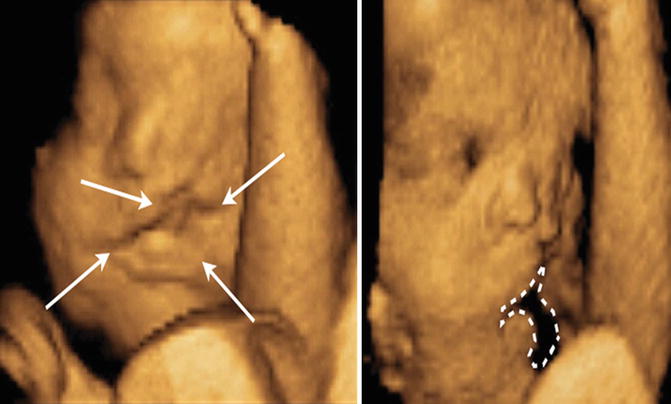
Fig. 16.4
Three-dimensional ultrasound in surface mode: detail of the wide, midfacial cleft lip and palate. Note the abnormal nose
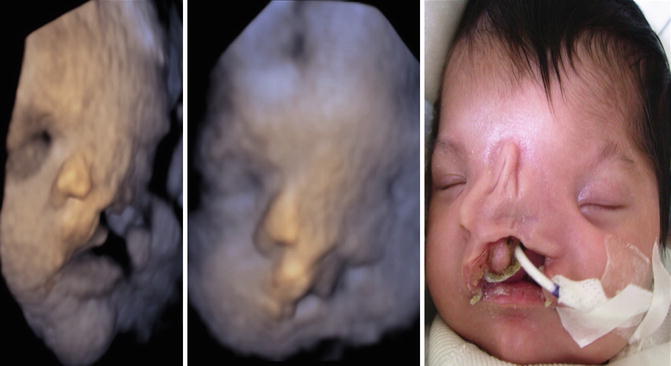
Fig. 16.5
Three-dimensional ultrasound using “glass body” rendering and newborn baby at delivery for comparison
16.3 Discussion
Failure or delay in midfacial development as well as any abnormal fusion of the medial and lateral nasal and maxillary prominences will result in developmental defects of the midface with varying degrees of severity, including cleft and hypoplasia. The midportion of the face, defined as the nose, upper lip, maxilla, primary palate, and zygomatic bones, starts to develop from the fifth week post-fertilization and is completed by week seven. This process involves the development and fusion of seven processes (the frontonasal process the paired lateral and medial nasal processes, and the paired maxillary processes) [9], and requires the coordination of both mesenchymal cells derived from the cranial neural crest which are covered by ectoderm [10, 13]. Mutations in signaling pathways genes such as fibroblast growth factor receptor (FGFR), WNT, transforming growth factor-beta (TGFβ), and bone morphogenetic protein (BMP) have been hypothesized. During morphogenesis, FGF regulates neural crest patterning [12] and FGFR 1 and FGFR 2 are widely expressed in facial mesenchyme and ectoderm [8]. In craniofacial development, WNT signaling plays critical roles in the generation, migration, and proliferation of cranial neural crest (CNC) cells in the facial processes in mice [11]. Perturbation of BMP, a member of the TGFβ superfamily, results in orofacial clefting because BMP acts by regulating cell proliferation, extracellular matrix synthesis, and cellular differentiation [13].
The use of 3D ultrasound was of value in the detection and characterization of the extension of the bony defect and closely correlated with postnatal findings. The technique allowed improved understanding of the abnormality and more thorough counseling to assist the parents in the decision-making process and antenatal management. In addition, 3D ultrasound enabled appropriate perinatal care by the multispecialty team by delivering the gold standard of care, avoiding neonatal complications, and providing accurate anatomic information for surgical plastic reconstruction.
Stay updated, free articles. Join our Telegram channel

Full access? Get Clinical Tree


